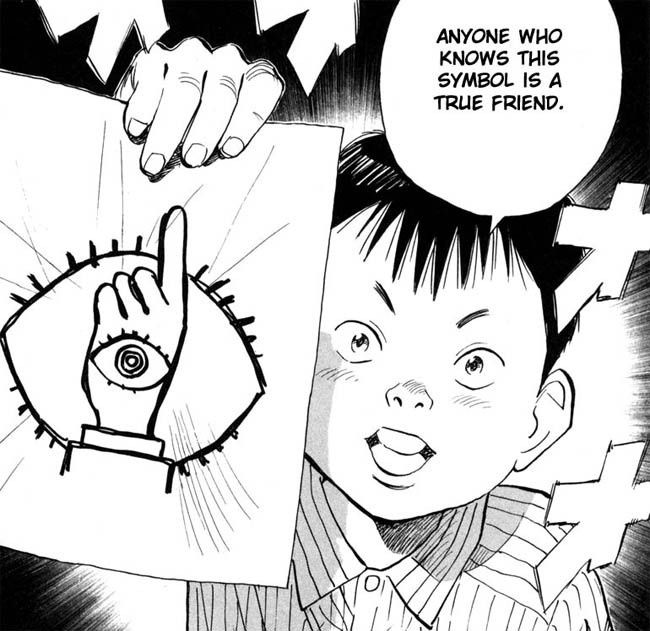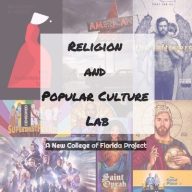(Spoilers Ahead!)
Naoki Urasawa’s 20th Century Boys is not a straightforward narrative. It is complicated and has many twists and turns, but this is to be expected of a series that strives to act as an exploration of the Aum Shinrikyo attacks. At the basic level, it is clear how 20th Century Boys tells the story of Aum, but it also attempts to examine how Aum and other new religious movements (NRM) present themselves, as well as question the very idea of “faith” without question.
20th Century Boys by Naoki Urasawa was written in 1999 and ran until 2006. While there are many characters, the story is initially guided by a man named Kenji Endo. As a child, he dreamed of saving the world and later of becoming a rockstar, but his dreams have long since fallen apart, and instead he now runs a convenience store with his elderly mother while taking care of his missing sister’s daughter. He still sees his friends often, and while they have also stayed in the same town and fallen into the same humdrum life as him, they are more content with their lot, getting married and forgetting their childhood dreams. Kenji is on the verge of doing the same, until one of his regular customers disappears and a symbol Kenji recognizes from his childhood games is found at the vanished man’s house. From here, Kenji becomes more entangled in investigations into a strange group using the symbol as their “name” and following their leader who they call “Friend”. During the story, Kenji discovers that many of the “prophecies” of “Friend” actually follow the stories of his childhood games and with the help of his childhood friends and the friendly neighborhood psychic, he tries to stop the group from taking over the world (Urasawa, 1999-2006).

Urasawa repeatedly draws parallels between “Friend” and Asahara Shoko, the leader of Aum Shinrikyo. One such example is the way both used spectacle to create the illusion of mystical powers. Towards the end of book 18, “Friend” is shown to supposedly levitate– behind the scenes, there’s really someone using a rope to pull him up, but the audience watching him are in awe (Urasawa JP 2005, US 2011). Even the men who pulled off the trick are in shock, but one comments that everyone is only seeing what they want to see. In a similar fashion, Shoko also claimed that he had levitated in 1985, and even said that he had been visited by Shiva when praying (Susumu & 島茴進 1995). Shoko made many claims about having spiritual powers, and he used them to great effect in recruiting members, saying that if they followed him they too would gain psychic powers (Metraux 1995). The videos of Shoko “levitating” are far from convincing, and many of Shoko’s claims of psychic powers have been proven to be laughably fake, but people still believed in them wholeheartedly, and some still do. In fact, as recent as 2018, reports indicated that Aum was still thriving, and potentially recruiting up to 200 people a year, even after all the convictions of high ranking members (Gunaratna 2018). Urasawa would have likely been aware of this continued belief when writing the scene where “Friend” supposedly levitated, as it was released in 2005 originally, and Shoko had been convicted in 2004 (Pletcher 2019). Perhaps Urasawa was not only trying to show the trickery used by Aum, but also the reaction of believers. In the manga, it is clear exactly what is going on, but everyone believes, and the set up of the panels and art even blurs the lines, making the reader think that maybe “Friend” really is floating (Urasawa JP 2005, US 2011). It raises interesting questions for the reader; does it really matter that the whole thing is sleight of hand? Should the followers be held accountable for believing in such an obvious trick, and why would they even believe it in the first place?

When it comes to trying to distinguish between cults and genuine religions, the character Kanna, the niece of Kenji and a later protagonist, illustrates these questions well. Kanna was present throughout the earlier story as well, but later on she becomes a leader of the resistance against the “Friend.” She acts as a foil to “Friend” in some ways throughout the story, further complicating how “Friend” and his group should be seen, which is fitting due to the fact that she is the daughter of “Friend”. While “Friend” claimed to have psychic powers, Kanna seems to possess real powers, even displaying them as a baby (Urasawa JP 1999 US 2009). She later uses them as an adult to bend spoons, noticeably standing behind the pulpit in a church, but unlike “Friend,” those watching do not immediately believe her (Urasawa JP 2002 US 2010). Quickly after this, she is attacked by a supporter of “Friend” who shoots at her, but she manages to turn the bullet on him. In this case, the reader is shown that these powers are legitimate, and there is no trickery involved, but ironically the audience in the church is slow to trust her. Jolyon Baraka Thomas argues in “Horrific ‘Cults’ and Comic Religion: Manga after Aum” (2012) that Kanna is meant to be viewed not just as a foil to “Friend,” but as a cult leader of sorts herself, only focused on doing what she believes to be right and just. This does make a certain amount of sense, but it could also be taken very differently. When Kanna uses the same skills and tricks as “Friend,” she instead uses them to benefits others. Using her charisma, she manages to convince the remaining people of the world to go to the Expo grounds to be safe from attack, knowing that “Friend” considers it to be “holy ground” (Urasawa JP 2006 US 2012). Some of her allies even reclaim the symbol from “Friend,” repurposing it from a symbol of a cult into a symbol of resistance and true salvation. In this way, it could also be argued that in these final chapters, Urasawa was blurring the lines of what can be considered a cult, but he doesn’t seem to have done it to cast the actions of Kanna and Kenji into doubt. Instead, the same skills and tools that can cause harm and destruction in one setting are utilize to save and protect people. The differences between “Friend” and Kanna seem to define how the skills are used– Kanna’s powers are legitimate, and she is not trying to use them for her own gain while “Friend” fakes his abilities and is only out for himself.

Summarizing and fully analyzing 20th Century Boys is not a simple task, and it can be interpreted in many ways, with substantial evidence being present to support many conclusions. But in a way, this complex and multitude of interpretations gets at what Urasawa could be hinting at– life and people are complicated, and not every facet is immediately visible. He by no means paints cults or Aum in a positive light, but instead seems to ask the reader to question what they see and take everything with a grain of salt.
Citations
- Urasawa, Naoki. 20th Century Boys. Vol. 1. San Francisco: VIZ Media LLC. Original Japanese run 1999-2006, Original English run 2009-2013.
- Gunaratna, Rohan. “Aum Shinrikyo’s Rise, Fall and Revival.” Counter Terrorist Trends and Analyses 10, no. 8 (2018): 1-6. https://www-jstor-org.ezproxy.lib.usf.edu/stable/26481827.
- Metraux, Daniel A. “Religious Terrorism in Japan: The Fatal Appeal of Aum Shinrikyo.” Asian Survey 35, no. 12 (1995): 1140-154. doi:10.2307/2645835.
- Pletcher, Kenneth. “Tokyo Subway Attack of 1995.” Encyclopædia Britannica. March 13, 2019. https://www.britannica.com/event/Tokyo-subway-attack-of-1995.
- Susumu, Shimazono, and 島茴進. “In the Wake of Aum: The Formation and Transformation of a Universe of Belief.” Japanese Journal of Religious Studies 22, no. 3/4 (1995): 381-415. http://www.jstor.org.ezproxy.lib.usf.edu/stable/30234460.
- Thomas, Jolyon Baraka. “Horrific “Cults” and Comic Religion: Manga after Aum.” Japanese Journal of Religious Studies 39, no. 1 (2012): 127-51. http://www.jstor.org.ezproxy.lib.usf.edu/stable/41495892.


